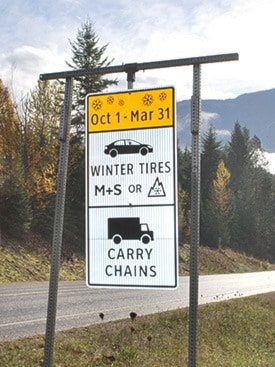Trisha Shanks
After October 1, most of British Columbia’s rural drivers are expected to be using winter tires by law. Winter tires are now defined as are either M+S (mud and slush) or winter rated (indicated by a mountain and snowflake pictograph.) Due to the possibility of unpredictable winter weather on mountain passes, the stipulated dates range from early Fall to early spring, ending March 31. Because British Columbia’s climate zones can range from freezing with a lot of snow to mild and slushy, tires are a huge safety consideration.
According to the Rural Highway Safety and Speed Review’s Technical Summary Report published in July 2014, the Motor Vehicle act’s definition of a ‘winter tire’ has not been updated since 1979. During the time since the last revision, advances in technology have resulted in the M+S tire now having the capacity to handle in winter conditions whereas before it did not.
“The Motor Vehicle Act (Section 208) currently has a broad definition of a winter tire dating back to 1979. Currently, a winter tire is defined as a tire that is represented by its manufacturer or tire retailer as a tire intended principally for winter use and that provides adequate traction in snow or mud. The Act also recognizes that winter tires must be in good condition, with a minimum tread depth of 3.5 millimetres. A review of the current definition found that both Mud and Snow (M+S) and Mountain/Snowflake rated tires are captured by the existing legislation, but not explicitly stated.”
This explains the confusion around new signage and obvious changes which now include both types of tires. The Government of BC’s driving and transportation web page now stipulates both types under the minimum legal requirement for winter driving conditions as either M+S (mud and slush) or the more familiar tires labelled with an image of a mountain and snowflake. These icons indicate a rating of ‘snow tires’ and by definition, according to the same report must offer a minimum of 10 per cent better traction than the M+S standard reference tire in slippery driving conditions.
“Because the winter mountain/snowflake tire test is a cumulative score in varied snow surface conditions (Soft Pack Snow, Medium Pack Snow, Medium Hard Pack Snow, Hard Pack Snow, and Ice) the 10 per cent improvement may not indicate a superior winter tire for all winter surface conditions,” the Ministry of Transportation’s report states in the section on winter tires.
Sixty per cent of B.C. drivers are located in a more temperate climate so the cities of Vancouver and Victoria are not included in the requirement for those driving on mountain passes. Most B.C. highways now require passenger vehicles to use M+S or mountain/snowflake tires, and commercial vehicles to carry chains between October 1 and March 31. The “designated Winter Tire and Chain-Up Routes” maps, available on the Ministry’s new Tires and Chains webpage, show the few sections of highways that do not require winter tires or chains during winter.
Dan McLean of Kal Tire in Nakusp spoke with the Arrow Lakes News,
“We were notified in a memo from our head office saying that they had changed the ratings, though I haven’t come in contact with a single customer who has stated that they feel comfortable just putting on a regular tire for winter driving. We recommend winter tires especially because you never know what you’re going to get around here. My wife had two accidents last winter. The conditions were horrendous, and the vehicle had almost top of the line winter tires. For anyone who thinks they can get by on an all-season, it’s not a good idea.”
ICBC recommends winter tires for driving in snow and ice, especially if driving in an area that gets a lot of precipitation because vehicles will be less prone to slide on the road in slippery conditions. According to Transport Canada’s Winter Tire Safety Tips webpage, all-season tires (M+S) “continue to provide safe all-weather performance, but may not always be suitable for severe snow conditions.” They will provide traction however are not up to extreme conditions as the snow rated tires are because they begin to lose their elasticity and grip on the road at temperatures below 7°C.
RCMP, CVSE (Commercial Vehicle Safety and Enforcement), and other policing agencies can prevent vehicles from travelling and issue tickets if a vehicle is not properly equipped for road conditions. Chains are required by commercial vehicles in extreme winter conditions.
